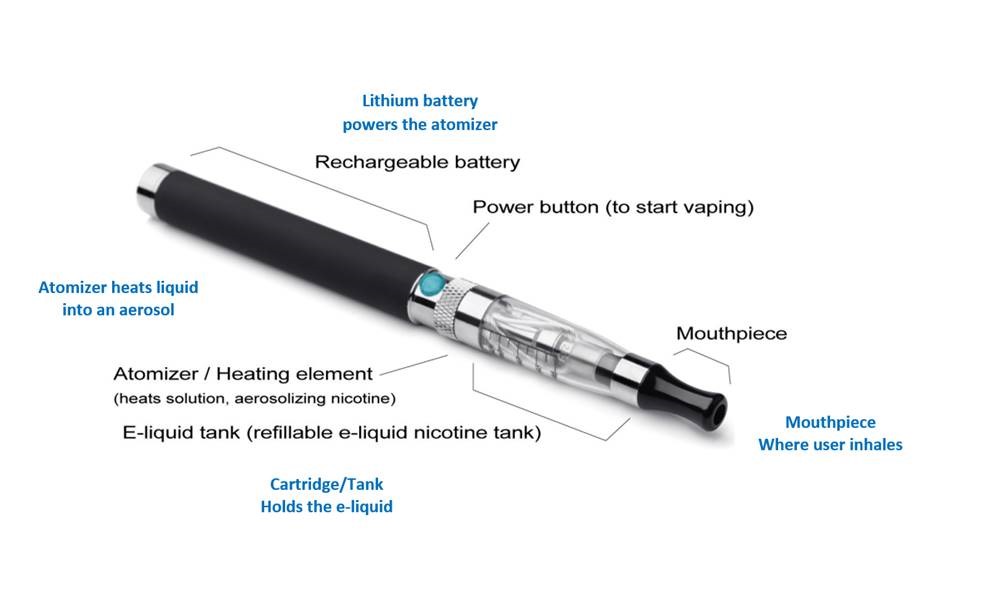- What are vapour products and what is vaping?
-
Vaping is inhaling aerosol or vapour produced by using vapour product devices. Vapour products are rechargeable, battery-powered devices that heat liquid into an aerosol that the user inhales into the mouth and lungs, where it is absorbed into the bloodstream. Vapour products do not contain tobacco; however, they may contain high concentrations of nicotine.
Vapour products have many names including e-cigarettes, vape pens, vapes, mods (box or mod), tanks, e-hookahs and e-nics. The four main parts to a vapour product are a lithium battery, an atomizer, a cartridge or tank and a mouthpiece. The lithium battery powers the atomizer to heat the liquid in the cartridge/tank into an aerosol which the user inhales through the mouthpiece.
- What’s in the E-Juice?
-
Most vaping liquids and substances are liquids and are commonly referred to as "e-juice" or "e-liquid."
Vapour products mostly contain:
- Propylene glycol
- Vegetable glycerin
- Flavor additives
- May or may not contain nicotine
Propylene glycol (PG) is a clear odourless colourless liquid and has a faintly sweet taste. It is commonly used as a food additive found in packaged foods, pet food and tobacco as an emulsifier and stabilizer to preserve moisture. PG is also used in cosmetic and household products including pharmaceuticals such as asthma nebulizers, shampoo and shaving products. The long term effects of inhaling PG is not known. PG provides the throat hit of the inhalation.
Vegetable glycerin (VG) or glycerine or glycerol, like glycol, is a clear odourless, colourless and sweet–tasting liquid derived from vegetable fats. It is added to food, cosmetics and pharmaceuticals. VG provides the vapour or cloud that is produced from exhalation from vapour products.
Flavourings: The addition of flavours disguise the chemical taste and smell of vapour products which makes vaping very appealing and desirable to youth.
Visit the Province of B.C. for The A-Z of Vaping.
- What’s in the Aerosol?
-
While vapour products may contain fewer harmful chemicals than smoke, they still have harmful chemicals in them.
Chemicals identified in aerosol include:
- Particulate matter that can be inhaled deep into the lungs
- Flavourings such as diacetyl, a chemical linked to a serious, irreversible lung disease
- Volatile organic compounds (VOC’s) such as benzene, ethanol, alcohol
- Tobacco nitrosamine such as nicotine and tobacco alkaloids
- Carbonyls such as formaldehyde, aldehyde
- Cancer–causing chemicals
- Heavy metals such as nickel, chromium and lead
Chemicals in the aerosol can be different than in the e-juice. Once heated, the e-juice goes through chemical reactions that form new compounds not previously found in the liquid such as formaldehyde.
The aerosol is not water vapour as many youth and adults believe.
- Are vapour products safe?
-
Vapour products effect health.
Youth are at most risk using vapour products with nicotine due to the developing brain up until age 25. Nicotine changes the way synapses are formed altering adolescent brain development impacting concentration, impulse control, decision-making, cognitive performance, mood, and nicotine withdrawal. Youth who use vapour products with nicotine are at increased risk to use other substances such as alcohol, tobacco and cannabis.
Nicotine is highly addictive, causes physical dependence and has detrimental effects on developing fetuses.
Vaping using nicotine affects breathing and increases a person’s risk of myocardial infarction increasing heart rate and blood pressure and constricting blood vessels. Respiratory symptoms can develop including wheezing, shortness of breath, and coughing.
New chemicals are created when the e-juice is heated and can create poisonous chemicals such as formaldehyde and acetaldehyde. Nicotine, chemicals, particulate matter, volatile organic compounds and cancer causing carcinogens in the aerosol can be inhaled by others in the second-hand aerosol.
Many of the toxic and cancer-causing chemicals in tobacco and the tobacco smoke form when tobacco is burned. Vaping products do not produce smoke, contain tobacco or involve burning. Except for nicotine, vaping products typically contain a fraction of the 7,000 chemicals found in tobacco smoke, lower levels of several of the harmful chemicals found in smoke.
Lithium-ion batteries used to power vapour products can explode causing injury and fires.
Vapour products may entice former smokers back to nicotine dependency, helping normalize nicotine dependency, and representing smoking as a socially acceptable public practice.
The long-term health effects of vapour products are unknown.
- Vaping to help quit smoking
-
As a quitting smoking and harm reduction tool for current adult smokers, vapour products are yet to be proven as effective cessation aides to quitting smoking. Health Canada has approved several forms of nicotine replacement products – for example inhalers, mist, gum and patches, but not electronic cigarettes. Nicotine users may be inhaling more harmful substances than their tobacco products. The longer-term risks of exposure to vapour products is unknown.
If you are a smoker, quitting smoking is the best thing you can do to improve your health. There is support available to help you quit from QuitNow.
If you are a smoker, the BC Smoking Cessation Program covers 12 weeks (84 days in a row) of free nicotine replacement therapy to all British Columbia residents each calendar year. BC residents who have active Medical Services Plan coverage can visit any pharmacy to access Nicorette gum or lozenges, Nicoderm patches or an inhaler.
More information about vaping and quitting smoking can be found on Health Canada’s website.





